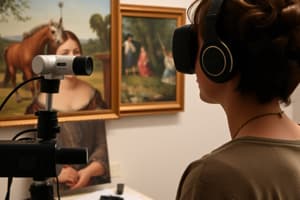Podcast
Questions and Answers
Videonystagmography is defined as:
Videonystagmography is defined as:
- A method that uses electrodes to measure electrical activity in the brain.
- A psychological assessment tool to diagnose mental disorders.
- Is a computerized, non-invasive, objective diagnostic procedure that measures eye movements. It consists of a battery of tests and is primarily used to evaluate the health and function of the vestibular system. (correct)
- An MRI technique used to assess brain structure.
These are involuntary, rhythmic, repetitive eye movements that can be horizontal, vertical, or rotatory.
These are involuntary, rhythmic, repetitive eye movements that can be horizontal, vertical, or rotatory.
Nystagmus
These are part of the battery of tests of the VNG procedure, EXCEPT:
These are part of the battery of tests of the VNG procedure, EXCEPT:
- Caloric testing
- Positioning testing
- Oculomotor testing
- Rotational testing (correct)
A Traumatic Brain Injury can trigger disorders like Benign paroxysmal Positional Vertigo (BPPV) or Ménière disease.
A Traumatic Brain Injury can trigger disorders like Benign paroxysmal Positional Vertigo (BPPV) or Ménière disease.
This percentage of TBI patients present vestibular features at 5 years and threefold increased unemployment in survivors:
This percentage of TBI patients present vestibular features at 5 years and threefold increased unemployment in survivors:
VNG test is a useful diagnostic tool in TBI cases because:
VNG test is a useful diagnostic tool in TBI cases because:
This is the average duration of a VNG procedure:
This is the average duration of a VNG procedure:
An ENT evaluation and a VNG test are performed in all TBI cases regardless of symptoms.
An ENT evaluation and a VNG test are performed in all TBI cases regardless of symptoms.
Who can perform a VNG test?
Who can perform a VNG test?
This is the gold standard test of VNG:
This is the gold standard test of VNG:
Study Notes
Videonystagmography (VNG)
- Defined as involuntary, rhythmic eye movements, which can be horizontal, vertical, or rotatory.
- Part of a comprehensive set of tests to assess vestibular function and balance.
Impact of Traumatic Brain Injury (TBI)
- TBI can trigger vestibular disorders such as Benign Paroxysmal Positional Vertigo (BPPV) or Ménière's disease.
- A significant percentage of TBI patients exhibit vestibular symptoms five years post-injury.
- Survivors of TBI show a threefold increase in unemployment rates, highlighting the long-term impact of such injuries.
VNG Test Utility
- Serves as an essential diagnostic tool in evaluating vestibular symptoms associated with TBI.
- Average duration of a VNG procedure varies, indicating the need for efficient assessment protocols.
Evaluation Protocol
- An ENT evaluation and a VNG test are standard procedures for all TBI patients, regardless of whether they present symptoms, ensuring comprehensive care.
Administration of VNG
- Can be performed by trained health professionals specializing in vestibular assessments, ensuring accurate diagnosis and management.
Gold Standard Testing
- The VNG test is recognized as the gold standard for assessing vestibular disorders, proving its reliability in clinical practice.
Studying That Suits You
Use AI to generate personalized quizzes and flashcards to suit your learning preferences.


